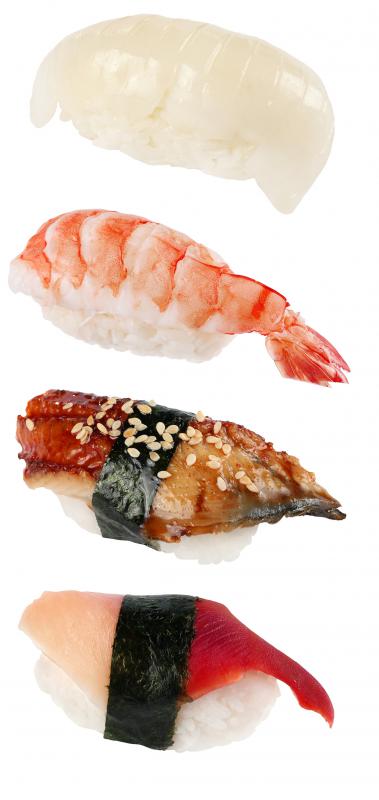At WiseGEEK, we're committed to delivering accurate, trustworthy information. Our expert-authored content is rigorously fact-checked and sourced from credible authorities. Discover how we uphold the highest standards in providing you with reliable knowledge.
What is Sticky Rice?
Sticky rice is a short-grain rice cultivar which has been bred to be especially sticky, and extremely low in starch, so the grains do not pull apart. This rice is used in a wide variety of Asian desserts, both in the form of rice flour and in the form of cooked whole grains, and it is served with savory Asian dishes as well. Many Asian markets and some large grocers carry sticky rice, with several varieties frequently on offer at larger establishments.
According to Chinese legend, sticky rice has been cultivated since around the first century CE, and it may be even older. Some botanists classify it as a separate subspecies within Oryza sativa, the rice genus, labeling sticky rice as O sativa ssp. glutinosa. This rice goes by a number of aliases, depending on where one is. In Japan, it is sometimes known as botan, mochi, pearl, or sushi rice, all references to ways in which it can be used. Thais often refer to it as sweet rice or waxy rice.

Sticky rice is also sometimes called glutinous rice, in a reference to the gluey texture the grains acquire while being cooked, rather than actual gluten; like other types of rice, glutinous rice is safe to eat for people who are gluten intolerant. The rice may be sold milled, in which case the outer husk is removed, or unmilled, in a pale brown variety. Brown sticky rice tends to be less sticky, although it is still gluier than other rice cultivars. It is also possible to find purple sticky rice, a Thai delicacy with a rich, nutty flavor.

This rice is cooked much like other varieties of rice, with around two cups of water to every cup of rice. Some cooks add coconut milk as the rice cooks, to intensify the flavor and make the dish into more of a treat, and when used for desserts, a small amount of sugar may be added as well. As the rice cooks, it releases the sticky compounds inside, turning into a sticky mass inside the cooking pot. The rice can be hand-formed into a variety of shapes, rolled in sushi, or served with savory or sweet dishes, where it will readily absorb juices. Some Thais like to eat sticky rice as a snack, dipping it into spicy sauces after molding it into balls.

This rice can be used in place of other rice varietals in many dishes, but other rices cannot substitute for sticky rice. They will not become as glutinous when cooked, changing the taste and texture of the dishes they are included in. If you really cannot obtain sticky rice for a dish, stick with a short-grain variety of rice, rinse it extremely well to remove the starch before cooking, and add a little less water than usual to create a chewy texture.
AS FEATURED ON:
AS FEATURED ON:














Discussion Comments
@ZipLine-- You could also make fried sticky rice. Sautee some garlic and beef (or sausage) in oil. Then add vinegar, sticky rice, fish sauce and soy sauce.
You could also add veggies to this if you want but I usually make it with meat, garlic and green onion only. This is a Chinese recipe that I learned from a friend.
@ZipLine-- You can make mango sticky rice with the extra steamed rice. Just give a round shape to the rice and pour coconut milk over it and let it sit for a few minutes. You will need a fresh, ripe mango though. The mango is sliced and served alongside the sticky rice and the rice is decorated with sesame seeds.
It's a simple dessert but very delicious. You must have heard of it, it's served at all Thai restaurants.
Can anyone give me an easy dessert recipe that I can make with steamed sticky rice? I made some sushi today but I prepared too much sticky rice and I don't want it to go to waste.
Post your comments